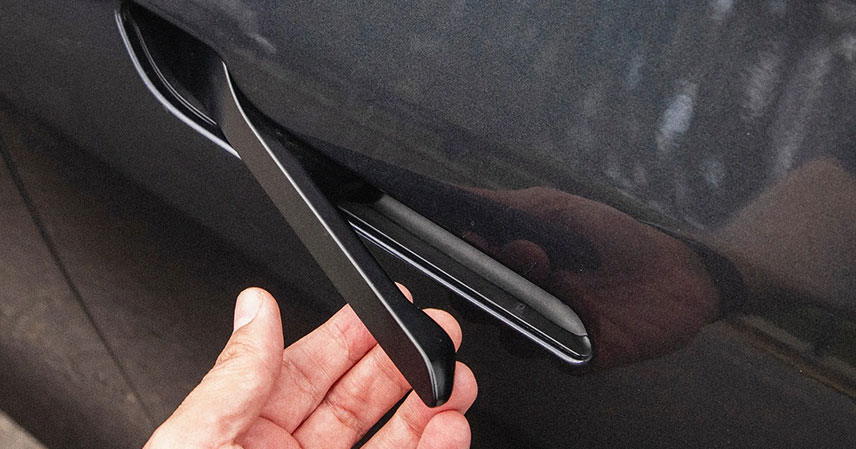For decades, the car door handle was an unremarkable component. It was a functional necessity, rarely given a second thought. Then came Tesla, reimagining everything. Their electronic, retractable door handles became a signature. They symbolized a bold, design-first approach to the electric vehicle era. This innovation inspired many global automakers to follow suit, pushing boundaries of automotive aesthetics.
However, this sleek innovation has recently faced intense scrutiny. It has highlighted a critical intersection between cutting-edge design and fundamental safety. What began as a design triumph is now at the center of a significant safety investigation. It has even led to tragic legal battles and impending global regulatory changes.
The Tesla Conundrum: Innovation vs. Safety 🚨
Tesla’s design philosophy prioritizes minimalism and digital integration. Their flush door handles contribute to the vehicle’s aerodynamic profile and futuristic aesthetic. They are undeniably sleek. This approach, however, has inadvertently created unforeseen safety challenges. The National Highway Traffic Safety Administration (NHTSA) launched an investigation into the 2021 Model Y’s door handles. This followed over 140 consumer complaints. These complaints detail alarming malfunctions.
Drivers reported handles getting stuck or failing to operate. This issue was particularly prevalent when the cars’ low-voltage batteries experienced problems. The implications of such failures are severe. Government filings reveal harrowing accounts. Parents reported their children were trapped inside vehicles. They could not locate or activate the mechanical rear-door releases. In some desperate cases, individuals allegedly had to break a window to regain entry or allow exit. This underscores the critical nature of reliable egress systems.
The human cost of these alleged design flaws is now tragically evident. Family members of two California teenagers recently sued Tesla. The teens died after the Cybertruck they were riding in caught fire in a crash. The lawsuit alleges that Tesla was aware of difficulties with manually opening its doors. Yet, the teenagers were reportedly trapped inside. This litigation brings a stark, somber reality to the debate. It questions whether design innovation can ever compromise basic, life-saving functionality.
China’s Bold Move: A Global Ripple Effect 🇨🇳
The safety concerns surrounding modern door handle designs are not confined to North America. China, the world’s largest automotive market, is now stepping in with decisive action. Its proposed new regulations could significantly alter global automotive design standards. The Ministry of Industry and Information Technology (MIIT) introduced these rules last month. They are poised to finalize after a comment period concludes in late November.
These regulations are comprehensive and uncompromising. They mandate the inclusion of mechanical release handles on both the inside and outside of every car. Crucially, these handles must be operable without tools, even after an accident. This directly addresses the critical issue of emergency egress. Furthermore, the rules appear to explicitly disallow flush door handles. Automakers will be required to design handles with sufficient space for a hand to grip behind them. This ensures usability and intuitive operation in all circumstances.
The implementation timeline for these rules is aggressive. They are set to kick in as early as mid-2027. This date is “around the corner” for global automakers. Vehicle design and development cycles typically span several years. China’s immense market power means these regulations won’t stay confined within its borders. Its influence often leads to the adoption of similar standards worldwide. This ensures consistency for manufacturers exporting vehicles. It also establishes a new baseline for what constitutes acceptable vehicle safety design.
The Engineering Headache: Redesigning a “Simple” Component ⚙️
At first glance, a door handle seems like a minor component. However, redesigning it to meet new safety standards presents a significant engineering challenge. Amy Broglin-Peterson, an expert in automotive supply chain management, highlights a crucial issue: the “real-estate problem in the door space.” Modern car doors are complex ecosystems. They house a myriad of components. These include intricate electronics, extensive wiring for various systems, insulation, and sophisticated speaker setups.
Integrating new mechanical handle mechanisms is far from simple. It requires careful re-engineering of the entire door structure. Any design change in one area inevitably impacts others. This can lead to unforeseen complications and cascading redesign requirements. Automakers must now find space for robust mechanical linkages. They must ensure these mechanisms are reliable and easily accessible. This is a formidable task, especially when balancing existing electronic systems and aesthetic considerations.
The financial implications are equally substantial. Rapidly implementing these design changes will be a pricey and complicated endeavor. The cost will vary depending on each automaker’s current design and manufacturing processes. However, it will undoubtedly involve significant investment in research, development, and retooling. This regulatory shift forces the industry to re-evaluate the fundamental balance. It weighs innovative aesthetics against unwavering, foundational safety requirements. It’s a costly but necessary recalibration for the entire automotive sector.
Key Insights 💡
- Safety Takes Precedence: The door handle saga unequivocally demonstrates that fundamental safety features cannot be compromised for design aesthetics or technological innovation.
- Global Regulatory Harmonization: China’s assertive regulations highlight the power of major markets to drive global safety standards, likely influencing automotive design worldwide.
- Complexity of “Simple” Components: A seemingly innocuous part like a door handle can harbor immense engineering complexity and critical safety functions, impacting entire vehicle systems.
- Significant Industry Impact: Automakers face substantial design, engineering, and financial challenges to adapt to these new safety mandates, requiring rapid innovation cycles.
- Evolving Design Paradigm: This issue signals a shift in automotive design, where basic, reliable mechanical functionality is being re-emphasized alongside advanced electronic systems.
The future of automotive design is at a crossroads. The humble door handle, once a symbol of sleek innovation, has become a potent reminder. It underscores the non-negotiable importance of fundamental safety. This ongoing narrative compels automakers to reconsider their priorities. They must now ensure that cutting-edge technology never overshadows the most basic human needs. These include the ability to safely exit a vehicle in any emergency. As these new regulations take hold, consumers can expect a renewed focus on practical, reliable safety features. The industry will undoubtedly adapt. It will integrate these lessons into the next generation of vehicles. This ensures that while cars become smarter and more connected, they remain fundamentally safe and accessible for everyone.
Source: New Rules Could Force Tesla to Redesign Its Door Handles. That’s Harder Than It Sounds



